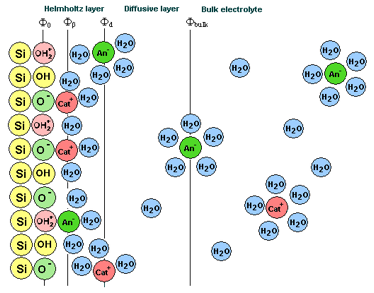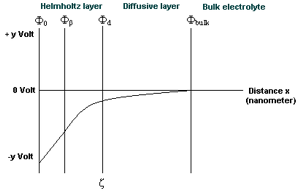Introduction
The aim of this project is to develop a nanofluidic device, which uses electrokinetics to separate biomolecules.
In nanofluidic devices, the behavior of molecules is different when compared to the bulk. Phenomena as electrical double layers, counterion distribution and electro-osmotic flow become very important because of the larger surface to volume ratio. Also in nanochannels the hydrodynamic resistance is very high, which is causing large pressure drops over the channel length. To design a nanofluidic separation device one could try to use the phenomena mentioned above. For example by adjusting the ionic strength, one can control the double layer length and thus the zeta potential profile in a nanochannel of a fused silica device (See figure 1 and 2).

Figure 1: The Electrical double layer near the surface of Silicondioxide. According to the pH and buffer solution this surface can be protonated or deprotonated. By a pH = 5 a negative surface potential will be provided.

Figure 2: The potential profile of Silicondioxide by a pH = 5. Note that the potential at the beginning of the diffusive layer the potential is called zeta potential (ζ).
Biomolecules as proteins or DNA are highly complex macromolecules of which the conformations are dependent of their environment (for example pH, salt concentration). Proteins can be straightened by treating them for example with Sodium Dodecyl Sulfate (SDS) en β-mercaptoethanol. According to the chosen detergent the net surface charge can be either positive or negative.
The device to be created must be an interplay between detergent treated proteins and the use of specific chosen nanofluidic phenomena to perform a separation on length.
Literature
Garcia et al. (2005), Lap Chip 5: 1271-1276.
Kirby and Hasselbrink (2004), Electrophoresis 25: 187-202.
Levine et al. (1975), J. Coll. Int. Science 52, 1: 136-149
Pu et al. (2004), Nano Letters 4, 6: 1099-1103.
Funding
This PhD assignment forms part of the flagship Nanofluidics of the NanoNed initiative of the Dutch government and is funded by Nanoned. Project duration 2005-2009.
Curious?
If you are curious in the above described device, or if you want for example to study biomolecular behavior in nanochannels, please contact us via the email address below. You can do graduation work or practical term with us.
Contact Information
Georgette Salieb-Beugelaar and or / Jan Eijkel
MESA+ Institute for Nanotechnology
University of Twente
P.O. Box 217
7500 AE Enschede
The Netherlands
Phone: +31 (0)53 489 2755 (Georgette) / +31 (0)53 489 2839 (Jan)
Fax: +31 (0)53 489 3595
E-mail: G.B.Salieb-Beugelaar@ewi.utwente.nl / J.C.T.Eijkel@el.utwente.nl
